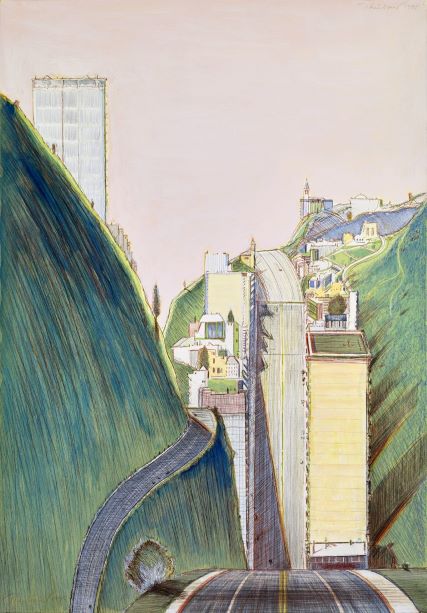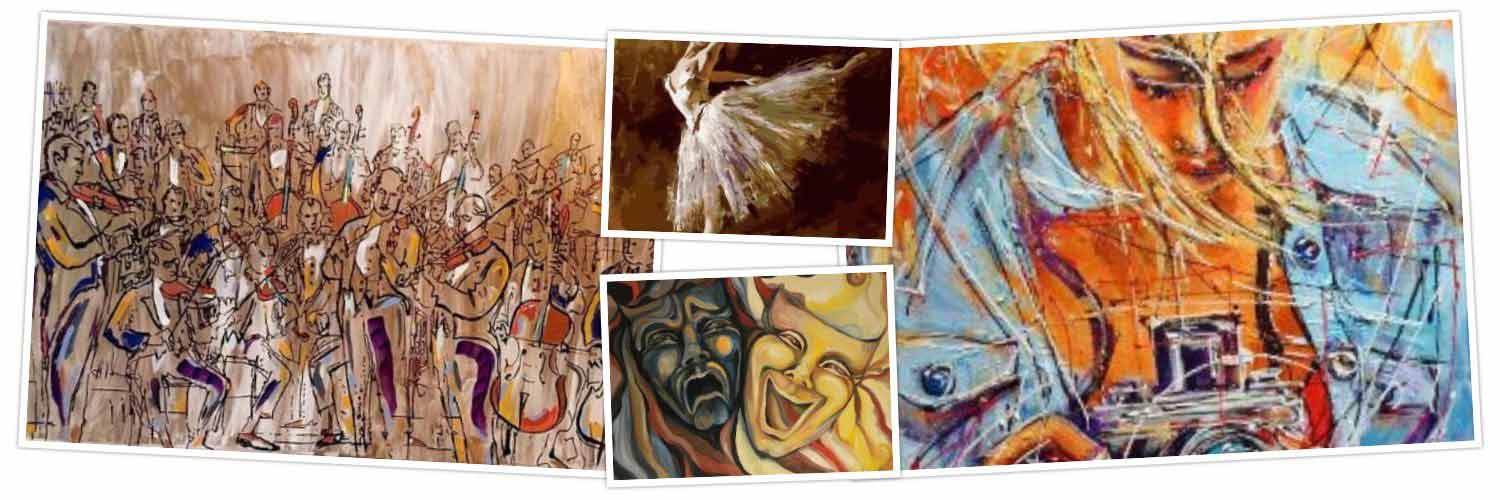Wayne Thiebaud at the McNay
by JASMINA WELLINGHOFF, Editor
When the Crocker Museum of Art in Sacramento decided to organize a tour of Wayne Thiebaud’s art to honor the artist who had just turned 100 years old, it reached to possible venues around the country, including the McNay Art Museum in San Antonio. They didn’t have to ask twice.
“On our part, there was a great deal of enthusiasm because we own three prints by Thiebaud in our collection,” said Rene Paul Barilleaux, the head of curatorial affairs at the McNay. “But we were also interested in presenting an exhibition that shows his remarkable paintings and drawings. We felt that the subject matter of his paintings is familiar and accessible to everyone – the food, the portraits, the landscapes – those are things that everyone can relate to, especially the food. That was a big part of our thinking. There’s a food culture here, in San Antonio, and food is connected to tradition, gatherings and community, a nice tie-in.”

Titled “Wayne Thiebaud 100: Paintings, Prints and Drawings,”the exhibit features 100 artworks to mark the artist’s 100th birthday. It’s a career-spanning show that highlights Thiebaud’s range of themes and interests, a body of work created over more than 70 years. In addition to pieces from the Crocker, the current exhibition includes works never seen before, which were drawn from the collection of the Thiebaud Family and Foundation.
The food paintings that Barilleaux is referring to are shown in the first part of the retrospective, featuring paintings of comfort foods, such as ice-cream cones, trays of cakes and pie slices, inspired by displays of food in cafeterias and diners from the 1960s. Thiebaud imbued these ordinary objects with meaning by painting them with obvious gusto and affection. The following quote reveals how he approached these paintings: “You take a lemon meringue pie. It’s quite a beautiful thing. It’s more than just a subject, it’s also a kind of relationship to the paint itself. You really feel like you are sort of making the meringue and working with the pie.” The paintings seem to combine a nostalgia for the treats of his youth with exploration of the painting process itself.
In addition to food, there are paintings of other objects, like shoes, for instance, hats and bow-ties, all rendered with realistic precision, elevating the ordinary into a sphere of symbolism.

The realism and precision are also visible in his portraits and other early paintings, possibly due to his early experiences as a commercial artist, but the works become more interpretive and abstract as you move further into the gallery where his stunning cityscapes and landscapes are displayed.
“He is an artist who is constantly challenging himself,” said Barilleaux. “He doesn’t want to be identified with any particular subject matter, so he learned to do portraits, he developed a way to create landscapes that are often composites of many landscapes; he is always challenging himself to grow and try new things. Whether it’s a portrait, a landscape or a still-life, each piece is beautifully rendered. You can see his hand in the brushwork.”
Brushstrokes may be there but the paintings change drastically with the cityscapes, apparently inspired by the steep streets and verticality of San Francisco and a good dose of imagination. Some landscapes, such as “The Sea Rolls in,” (oil on canvas) are largely abstract but still convey what their titles imply.
Toward the end of the gallery, you’ll see paintings from the 1990s, including a couple of works inspired by the landscape of the Sacramento River Delta, complete with meticulous renditions of adjacent agricultural fields, all seen as you would imagine seeing them from the air. According to an article in the New York Times, the artist literally walked around and explored in person “the fields and levees” of the landscape.
Thiebaud was born in Meza, Arizona in 1920, but his family moved to Los Angeles when he was still a baby. According to a bio published in TheArtStory, as a teenager, he worked part-time designing posters for a movie theater while also working at a café in Long Beach named “Mile High and Red Hot” that sold ice cream and hot dogs. He later took a summer job in the animation department of Walt Disney Studios and studied commercial art in high school and at the Los Angeles Trade-Technical College. After serving in the Army Air Force in the early 1940s, he continued his studies at the university level. The artist eventually met New York art dealer Allan Stone who became Thiebaud’s exclusive dealer until his (Stone’s) death.
Today, Thiebaud is recognized as one of the most respected artists in the U.S. In 1994, he received the National Medal of Arts, and in 2017 he was awarded the Gold Medal for Painting by the American Academy of Arts.

So, how would Barilleaux define Thiebaud’s impact on the contemporary art scene?
“I think that he shows that craft is still important in art, that you can create a painting reveling in the mastery of brush strokes, things that were historically important and are still relevant. He used that mastery to elevate the ordinary objects he painted. He has also influenced a lot of artists; he’s really an artists’ artist, not a flashy one.”
Asked to name his favorite works in the current exhibit, Barilleaux singled out the still lifes representing single objects, right by the entrance to the show. “They are all single objects like a can of sardines, an ice cream cone, an ice cream sundae; there are eight of them. They represent his mastery in transforming ordinary objects into icons. I would hate for people to miss those.”
————————————————————————————————————————
McNay Art Museum, 6000 N. New Braunfels, 78209; www.mcnayart.org, 210-824-5368. Closes Jan. 16, 2022; Exhibition pairs with McNay-organized exhibits “Art of SA Eats/Sabor a San Antonio” and “Beth Van Hoesen and Wayne Thiebaud: Friendship and Community” on view through Jan. 23, 2022.
